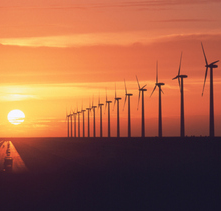 By year's end, nearly 1,400 MW of wind energy will have been installed in Canada in 2011, representing a calendar-year record. However, despite this achievement, significant challenges loom ahead, explained Robert Hornung, president of the Canadian Wind Energy Association, at the association's Annual Conference and Exhibition.
By year's end, nearly 1,400 MW of wind energy will have been installed in Canada in 2011, representing a calendar-year record. However, despite this achievement, significant challenges loom ahead, explained Robert Hornung, president of the Canadian Wind Energy Association, at the association's Annual Conference and Exhibition.
According to Hornung, 23 new wind farms will be constructed in nine provinces by the end of the year. These projects, he said, represent $3.5 billion in investment and 13,500 person-years of employment. Canada will end 2011 with about 5,400 MW of total installed capacity. Further, the nation's installed wind energy capacity will more than double over the next five years.
‘There are signed contracts already in place for more than 2,000 MW in each of Ontario and Quebec, and for more than 500 MW in British Columbia alone,’ Hornung said. ‘The next five years will provide significant business opportunities in Canada for the wind energy supply and value chains.’
Thanks to the current targets and commitments from provincial governments, Canada could have an installed wind energy capacity of 14,000 MW by 2016, Hornung added, citing the new procurement processes launched in Saskatchewan, Nova Scotia and Quebec.
Despite all the effort, there is significant uncertainty about future procurement opportunities in British Columbia, Manitoba, Ontario, New Brunswick, Prince Edward Island and Newfoundland.
In fact, only Ontario and Nova Scotia have overall visions for wind energy development after 2016. But with political uncertainty in Ontario, and because Nova Scotia – which mandates that 40% of its electricity come from renewable resources by 2020 – represents a small market, there is a pressing need for other provinces to step up.
Hornung stressed that the industry needs to create a long-term, stable and sustainable market for ongoing wind energy development in Canada. To do that, he said, the wind industry must work in concert with provincial and local governments not only to ensure the ‘sanctity of signed contracts,’ but to make sure interconnection and permitting rules are not changed for the worse.
He spoke of the need to ‘depoliticize’ wind energy, meaning that the industry needs to act as a good neighbor in every community that houses a wind farm. Failure to do so, he said, can have a domino effect on surrounding development.
‘When wind energy becomes a political issue, political expediency can substitute for rational decision-making,’ he said. ‘The future of wind in Canada is not guaranteed. Significant work must be done to ensure current commitments are met and future opportunities emerge.’



